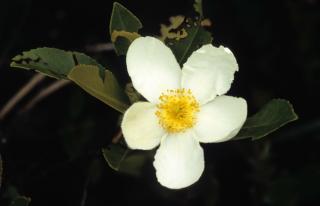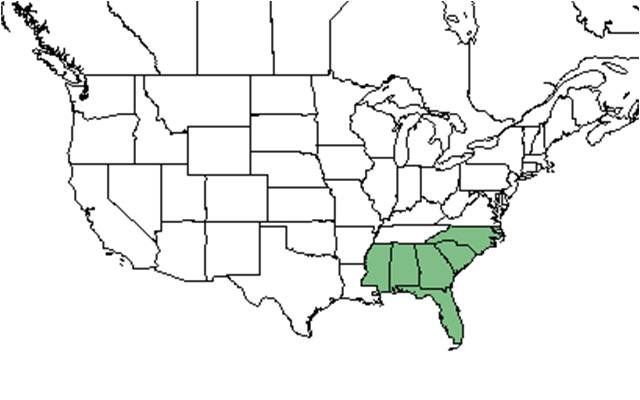Difference between revisions of "Gordonia lasianthus"
KatieMccoy (talk | contribs) |
KatieMccoy (talk | contribs) (→Diseases and parasites) |
||
| Line 64: | Line 64: | ||
===Diseases and parasites=== | ===Diseases and parasites=== | ||
| − | ''G. lasianthus'', ''M. virginiana'' and ''Persea borbonia'' can be found growing together in bayheads and Carolina Bays. Laurel wilt disease is a fungal disease transmitted by ''Xyleborus glabratus'' a non-native beetle, and causes ''Persea borbonia'' to die. With the death of ''Persea borbonia'' there is an increase in open canopy gaps, which ''G. lasianthus'' and ''M. virginiana'' encroach and cause an alteration of the community composition and structure. More seedlings of ''G. lasianthus'' have been observed at these sites, suggesting that it will become the most dominant species over time (Spiegel and Leege 2013). It has been observed that ''G. lasianthus'' is not effected by ''Xyleborus glabratus'' (Mayfield and Hanula 2012). | + | ''G. lasianthus'', ''M. virginiana'' and ''Persea borbonia'' can be found growing together in bayheads and Carolina Bays. Laurel wilt disease is a fungal disease transmitted by ''Xyleborus glabratus'', a non-native beetle, and causes ''Persea borbonia'' to die. With the death of ''Persea borbonia'' there is an increase in open canopy gaps, which ''G. lasianthus'' and ''M. virginiana'' encroach and cause an alteration of the community composition and structure. More seedlings of ''G. lasianthus'' have been observed at these sites, suggesting that it will become the most dominant species over time (Spiegel and Leege 2013). It has been observed that ''G. lasianthus'' is not effected by ''Xyleborus glabratus'' (Mayfield and Hanula 2012). |
Root rot can be a problem for this species when young<ref name="wildflower"/>. | Root rot can be a problem for this species when young<ref name="wildflower"/>. | ||
Revision as of 16:31, 16 December 2015
| Gordonia lasianthus | |
|---|---|

| |
| Photo taken by Gil Nelson | |
| Scientific classification | |
| Kingdom: | Plantae |
| Division: | Magnoliophyta - Flowering plants |
| Class: | Magnoliopsida - Dicotyledons |
| Order: | Theales |
| Family: | Theaceae |
| Genus: | Gordonia |
| Species: | G. lasianthus |
| Binomial name | |
| Gordonia lasianthus (L.) Ellis | |

| |
| Natural range of Gordonia lasianthus from USDA NRCS Plants Database. | |
Common name: loblolly bay
Contents
Taxonomic notes
Description
A description of Gordonia lasianthus is provided in The Flora of North America.
Loblolly bay is a perennial, evergreen tree with large, white, fragrant, cup-shaped flowers. The leaves are leathery, entire, oblong and oblanceolate and will turn scarlet in the fall[1][2]. It often grows with sweet bay, (Magnolia virginiana) and is easily distinguishable by having a light green underside while sweet bay has a white underside [3].
Distribution
Found in hydric habitats throughout the Coastal Plain.
Ecology
Habitat
Gordonia lasianthus has been found along margins of titi swamps, densely wooded hammocks, swampy depressions, cypress domes, an ecotone between a titi-sweet bay swamp and a pond pine flatwood, ravine bottoms, shrub bogs, wet pine flatwoods, mesic steepheads, pocosins, bayheads, and bald cypress/mixed hardwoods swamps. Seedlings have been observed to require significant site disturbance exposing mineral soil, to become established (Gresham and Lipscomb 1985). It has been found to occur in disturbed areas such as cut-over pinewoods and powerline corridors (FSU Herbarium). Grows in acidic, swampy soils, with an accumulation of organic matter. Soil types include Spodosols, Inceptisols, Ultisols, and Histosols[4] and has been observed to grow in loamy sand (FSU Herbarium). Associated species include Stewartia, Illicium, Ilex opaca, Ilex glabra, Persea borbonia, Magnolia glauca, Rhus vernix, Clethra, Cliftonia, Nyssa sylvatica, Cyrilla racemiflora, Pinus elliottii, Quercus nigra, Liquidambar, Magnolia virginiana, Oxydendron, Illicium floridanum, Myrica cerifera, Liriodendron, Pickneya, Rhododendron viscosum, Lyonia lucida, Serenoa, Osmunda, Sphagnum, and Lycopodium (FSU Herbarium).
Loblolly bay is rarely observed to occur in pure stands (Gresham and Lipscomb 1985), but has been observed to be the dominate canopy in some Carolina bays (Dimick et al. 2010).
Phenology
The large, white fragrant flowers can be found flowering May through July (FSU Herbarium). The fruit is a hard, woody, five-valved capsule about 0.6 inches long; four to eight flat, winged seeds can be found in each valve [4].
Seed dispersal
The majority of seeds fall with in a radius three times the height of the parent tree. Wind shakes the seeds out of the capsules; and the empty capsules will remain attached to the parent tree until peduncle and capsule abscission[4].
Seed bank and germination
Germination of loblolly bay is epigeal and most seedlings do not live past the first growing season [4].
Fire ecology
Gordonia lasianthus usually occurs in areas that do not experience a lot of fire, such as bayheads . Swamps dominated by pondcypress can develop into bays dominated by G. lasianthus when fire is suppressed and there is an accumulation of organic matter. Organic matter accumulates in unburned areas, providing a desirable habitat for G. lasianthus to germinate and grow (Casey and Ewel 2006).
Following a disturbance, such as fire, G. lasianthus is a sprouter, recovering vegetatively from roots or stems. Sprouters invest more energy into below ground structures and produce fewer seeds, and are favored in systems with severe and frequent disturbance. G. lasianthus occurs commonly in bayheads, which have one of the lowest fire frequency of any forested wetland in Florida, but due to the deep organic soil, it can ignite during the dry season. The thin bark of G. lasianthus does not provide much insulation from smoldering heat, causing a low survival rate in bayhead interiors, where there is a lot of smoldering post-fire. G. lasianthus has the highest survival rate near bayhead edges, where char heights are the greatest, causing G. lasianthus to basally resprout (Matlaga et al. 2010). Severe disturbance promotes basal sprouting and mild disturbance promotes sprouting in the tree crown (Bond and Midgley 2001).
Seedlings have been observed in plowed fire lines around a site that received a winter burn, but none were observed within the burned area (Gresham and Lipscomb 1985).
Pollination
Flowers are pollinated by bees, flies and hummingbirds [4].
The following Hymenoptera families and species were observed visiting flowers of Gordonia lasianthus at Archbold Biological Station (Deyrup 2015):
Sphecidae: Ectemnius rufipes ais
Vespidae: Pachodynerus erynnis, Polistes dorsalis hunteri
Use by animals
Deer eat the foliage[1].
Diseases and parasites
G. lasianthus, M. virginiana and Persea borbonia can be found growing together in bayheads and Carolina Bays. Laurel wilt disease is a fungal disease transmitted by Xyleborus glabratus, a non-native beetle, and causes Persea borbonia to die. With the death of Persea borbonia there is an increase in open canopy gaps, which G. lasianthus and M. virginiana encroach and cause an alteration of the community composition and structure. More seedlings of G. lasianthus have been observed at these sites, suggesting that it will become the most dominant species over time (Spiegel and Leege 2013). It has been observed that G. lasianthus is not effected by Xyleborus glabratus (Mayfield and Hanula 2012).
Root rot can be a problem for this species when young[1].
Conservation and Management
Cultivation and restoration
Photo Gallery
References and notes
Deyrup, M.A. and N.D. 2015. Database of observations of Hymenoptera visitations to flowers of plants on Archbold Biological Station, Florida, USA.
Florida State University Robert K. Godfrey Herbarium database. URL: http://herbarium.bio.fsu.edu. Last accessed: October 2015. Collectors: Loran C. Anderson, Sarah Baxter, James R. Burkhaulter, N.H. Chevalier, Andre F. Clewell, H.S. Conard, H.A. Davis, Wayne R. Faircloth, A. Gholson Jr., R.K. Godfrey, D.W. Hall, Don Harrison, E.A. Hebb, R. Kral, O. Lakela, S.W. Leonard, Hui Lin Li, T. Myint, J.B. Nelson, Jackie Patman, James D. Ray Jr., C. Rhinehart, P.L. Redfearn Jr., Grady W. Reinert, Cecil R. Slaughter, A.G. Shuey, R.R. Smith, E. Tyson, D.B. Ward, Jean W. Wooten. States and Counties: Florida: Alachua, Baker, Bay, Columbia, DeSoto, Dixie, Escambia, Flagler, Franklin, Gadsden, Hamilton, Hardee, Highlands, Hillsborough, Jefferson, Lake, Leon, Liberty, Madison, Manatee, Marion, Nassau, Okaloosa, Orange, Polk, Putnam, Seminole, Taylor, Volusia, Wakulla, Walton. Georgia: Clarke, Grady. Pennsylvania: Phillidelphia. South Carolina: Pickens. Compiled by Tall Timbers Research Station and Land Conservancy.